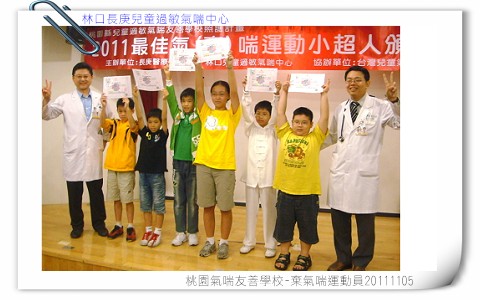Chuang Gung Medical Foundation, Division of Pediatric Allergy, Asthma and Rheumatology - UNREGISTERED VERSION
Main menu
Education for Schools
Health Education for Asthma – Schools
Liang-
Here are a few guidelines that teachers should follow when caring for the campus life of asthmatic students:
(I). Teachers and students should be aware of the early symptoms of an asthma attack, and advise the student to seek medical attention as soon as possible, adjust the usage of medicines, and take special care during daily life. Some of the possible symptoms of an acute asthma attack are as follow:
(1) Slight wheezing, coughing or chest tightness during breathing.
(2) Discomfort or severe coughing when going up the stairs or during gym class; ability to exercise is limited.
(3) Decreased peak expiratory flow (PEF), lower than the 80% of the personal best value.
(4) Increased frequency of using an inhaled fast-
(II). Allergic students should prevent exposure to environments with airborne allergens or stimulants.
(1) Schools should regularly clean dust and areas with possible dust mite allergens and other stimulants, such as old books in libraries or storage rooms for cleaning and sport equipment.
(2) Schools should maintain proper kitchen sanitation, properly dispose of food waste, maintain dryness in the kitchen, and patch up possible entrances of cockroaches to prevent cockroach infestation.
(3) During laboratory classes, students proven to be allergic to animal hair should avoid exposure to furry animals, such as guinea pigs and mice.
(4) Although dust blown during cleaning could lead to asthma attacks, students should still participate in group activities. During cleaning activities, students should wear masks to prevent inhalation of chalk dust, avoid using toilet cleaners, and stay away from dusty construction works. Even with asthma, these students are still capable of doing normal work as other students.
(III). Patients with asthma should perform longer warm-
(1) Parents should communicate with physical education teachers that their cessation of sport activities is not due to laziness, but from asthma.
(2) Perform at least 30 minutes or more warm-
(3) Sports activities suitable for asthmatic children: in principle, choose exercises with chances for intermittent rest, such as swimming, volley ball, badminton and gymnastics. Find a sport that is suitable to the individual.
(4) Avoid exposure to airborne stimulants; avoid dusty construction works in the school.
(5) When symptoms persist after non-
(IV). School nursing staff and teachers may use instructional videos or participate in asthma seminars, held infrequently by the School Nurse Association, to enrich their own knowledge of asthmatic care, and to be prepared to take actions during acute asthma attacks. This will ensure the asthmatic students have a normal school life, receive balanced and normal physical/mental development, and good asthma care. Encourage children to exercise regularly, join club activities, as doing so will help their body and mind to develop normally. Also, teachers should inform the children’s classmates that asthma and atopic dermatitis are non-

